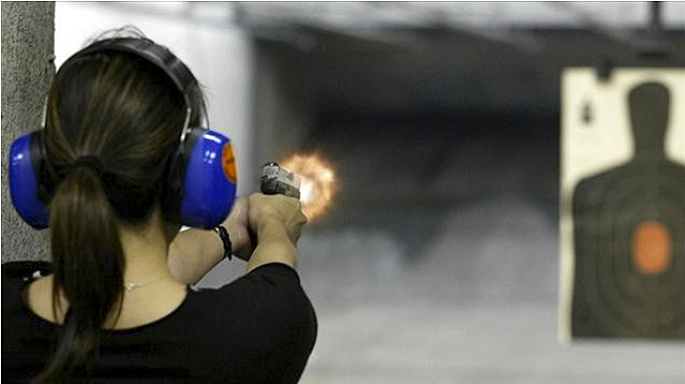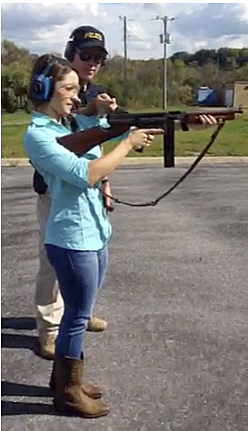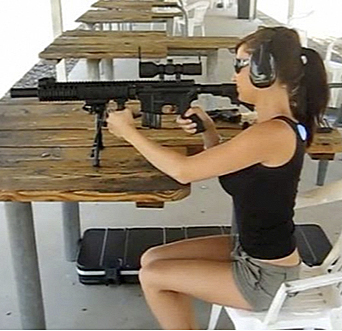
- Articles
Women, Guns, and the Medical Literature — A Raging Debate
It is becoming abundantly clear that the mainstream liberal media and the entrenched political medical establishment support draconian gun control measures that would ultimately lead to the confiscation and banning of firearms. Driven by liberal medical journal editors, vociferous administration officials, and taxpayer subsidized, gun control-oriented research, the political establishment has propounded the Public Health/Epidemiologic model to confront the conveniently media-tagged issue of guns and violence.(1) This view espouses the erroneous concept of guns and bullets as virulent pathogens that need to be stamped out by limiting gun availability and ultimately eradicating guns from the citizenry. The only problem is that guns and bullets are inanimate objects that do not follow Koch’s Postulates of pathogenicity. This is, in reality, a campaign orchestrated by gun prohibitionists and proponents of big government who are willing to exploit our understandable concern for street violence and sensationalized crime statistics to advance their agenda for an ever-increasing government, domestic socialism, and the virtual emasculation of constitutional government, that in the final analysis can come about by total citizen disarmament.

The monolithic wall of the entrenched political medical establishment was breached with the January 1994 issue of the Journal of the Medical Association of Georgia. In that issue the preeminent criminologist, Professor Gary Kleck of Florida State University, author of the influential book, Point Blank: Guns and Violence in America (1991), analyzed the study of Arthur Kellermann, M.D. and associates at the Center for Injury Control at Emory University. Their study purported to have found that of people killed at home, 76% were shot by a family member or an acquaintance, and concluded that persons who keep guns in their home are themselves more likely to be victims of homicide than those who don’t. In the words of the authors, “Rather than confer protection, guns kept in the home are associated with an increase in the risk of homicide by a family member or intimate acquaintance.(2)
Methodology Flaws
Prof. Kleck’s analysis discloses several flaws in the methodology. First, “violent households” would be expected “to be more likely to own guns than people in less violent households, even if guns themselves made no contribution at all to the violence.” Second, Prof. Kleck asserts, “because their study did nothing to distinguish cause from effect…,” we know nothing about “risk-increasing or risk-decreasing, of keeping guns for self-protection.” In other words, we do not know what percentage of gun uses were for self-protection and which ones were criminal. For example, 63% of the “victims” were men; yet we do not know how many of these homicides represent genuine acts of self-defense by women against abusive husbands or lovers, and committed as justifiable homicides. In fact, according to the authors, “a majority of the homicides (50.9%) occurred in the context of a quarrel or a romantic triangle.”(1) In this regard, it should be pointed out that other investigators had concluded that “about half of shootings by one spouse or the other are defensive killings of husbands by victimized wives. So it misleadingly characterizes many cases in which guns save innocent lives as gun murders.”(3)
Moreover, only gun uses that resulted in death were analyzed, thus the study ended up excluding the vast majority of gun uses that do not result in death, and which are more likely to be defensive uses by victims of crime, to protect themselves.(2-4) In fact, as Prof. Kleck points out in his critique, “at least 3/4th of all uses of guns in crime-related incidents are defensive uses by the crime victims.”(3)
Dr. Kellermann and his associates have unfortunately gone along with the faulty post hoc ergo propter hoc reasoning, “after it therefore because of it,” which blames guns on the rise of crime and violence in America. As a neurosurgeon who has spent incalculable hours in the middle of the night treating victims of gunshot wounds, I also deplore the rising violence and crime in America — but we must have the moral courage to find the truth and recognize the fact that there is another side to the story that is seldom promulgated. The floodgates of dissension were opened when the March 1994 issue of the Journal of the Medical Association of Georgia asserted that physicians have a professional obligation to base their opinions on objective data and scientific information rather than on emotionalism or political expediency. And. after devoting a whole issue to the topic of guns and violence, concluded that objective cumulative data indicates that indiscriminate gun control disarms the law-abiding citizens while it does not prevent criminals and street thugs from perpetrating crimes on unwary victims. Moreover, guns in the hands of law-abiding citizens deter crime and clearly afford the benefit of self-protection.(6)
The FBI statistics reveal that 75 percent of all violent crimes for any locality are committed by six percent of hardened criminals and repeat offenders. Moreover, the typical murderer has had a prior criminal history of at least six years with four felony arrests in his record before he finally commits murder. This compares with the fact that less than 2% of crimes committed with firearms are carried out by licensed law-abiding citizens. The vast majority of criminals obtain their guns illegally which is not difficult since there are already over 200 million guns in circulation in the U.S.(5,6)
A ban on gun ownership would not only be unconstitutional but also impossible to execute. Americans know that they not only have a right to self-protection, but also understand that the right embodied in the Second Amendment is the right that secures all others. There are approximately 500,000 police officers in the United States.(7) Thus, assuming three 8-hour shifts and other circumstances (vacations, leaves, etc.), there would only be125,000 police on duty at any given time to protect a population of 250 million.
Moreover, the duty of the police officers is not to prevent crime (they cannot), but to apprehend criminals and bring them to justice after a crime has been committed. They cannot be in all places at all times. Furthermore, contrary to popular belief, the police do not have a legal duty to protect the public against criminals. According to several court opinions including a 1982 ruling (Bowers v. De Vito), “there is no constitutional right to be protected by the state against being murdered by criminals or madmen. The constitution…does not require the federal government or the state to provide services, even so elementary a service as maintaining law and order.”(8)
What this amounts to is that in the final analysis the state has no legal responsibility to protect individual citizens from crime. The state only assumes a collective duty to the community at best. This is one of the reasons why law-abiding American citizens must preserve their constitutional right “to keep and bear arms,” and must assume some responsibility to protect themselves from street thugs and ruffians running and stalking the streets of America, as the 1992 Los Angeles riots so well demonstrated. Moreover, Prof Kleck has noted, “citizens acting in self-defense kill about three times more assailants and robbers than do the police.” In his scholarly compiled book, he garners statistics evincing that the defensive uses of handguns by citizens surpass their criminal uses because many citizens in America own guns for self-protection. Yes, firearms are used more frequently by law-abiding citizens to repel crime than by criminals to perpetrate crime.(2,5) Moreover, criminologist Don B. Kates, Jr. and medical editor Patricia T. Harris maintain that “…by focusing on homes the statistics exclude the numerous instances in which shopkeepers kill robbers. When the number of abused wives and shopkeepers who shoot criminals is accounted, the figure for defensive killing increases by about 1,000 percent..”(4) Furthermore, “firearms (including handguns) are used another 215,000 times each year by citizens to defend themselves against dangerous animals (i.e. snakes, rabid skunks, etc.).”(4,7) Likewise, “assault weapons” have been used by private citizens to protect themselves and their property during crises, as Korean shopkeepers amply demonstrated protecting their property during the L.A. riots and Florida residents evidenced during the looting rampages that followed in the wake of the devastating Hurricane Andrew.

And so it is not surprising that in a survey of 1800 prison inmates, 81% agreed that a smart criminal tried to find out if his potential victim is armed, 74% said that burglars avoid houses when people are home because they fear being shot, and 34% admit to having been scared off, shot at, wounded, or even captured by armed citizens.(9-10)
More recent data gathered by Prof. Kleck (1993) reveals that given the relative use of guns for self-protection versus criminal uses: “[The] life-saving uses of guns annually…would dwarf the nearly 37,000 lives taken with guns.”(3) As Edgar Suter, M.D., chair of Doctors for Integrity in Research and Public Policy, has pointed out from his scholarly review of the available literature, “as many as 75 lives are potentially saved for every life lost to a gun.” In his estimation, the beneficial uses of guns have not been properly portrayed in the medical literature or the popular press.(11)
Women and Guns
National Victims Data suggests that “while victims resisting with knives, clubs, or bare hands are about twice as likely to be injured as those who submit, victims who resist with a gun are only half as likely to be injured as those who put up no defense.”(5) Similarly, regarding women and self-defense, “among those victims using handguns in self-defense, 66% of them were successful in warding off the attack and keeping their property. Among those victims using non-gun weapons, only 40% were successful.
Among those victims fleeing the scene, only 35% were successful. Among those victims invoking physical force, only 22% were successful. Among those using verbal shouting only 20% were successful..”(5) The gun is the great equalizer for women when they are accosted in the street or when they are defending themselves and their children at home.
In the U.S., women who do not know how to protect themselves continue to be targets of crime. According to a survey by William Barnhill of The Washington Post, “73% of all women now over the age of 12 will be victimized, more than a third of them raped, robbed, or assaulted at some point in their lives.” But women are beginning to fight back. In the U.S., at least 12 million women now own handguns. Thus, according to Tracey Martin, former manager of the National Rifle Association’s Education and Training Division, “a gun can make the difference between being the victim or the victor in a confrontation with a criminal.” And Paxton Quigley, who once advocated gun control but now recommends that women learn to protect themselves with handguns, states, “guns in the hands of women who know how to use them do deter crime.”(12) As Robert J. Kukla wrote in his book Gun Control, “today…a dainty and delicate woman, with courage and determination, is more than the equal of any brute who ever trampled the sand of a Roman arena. The difference is the firearm.” (13)

Firearm safety training is essential for citizens, particularly women who intend to use guns for self-protection. And it does reduce crime. Robert W. Lee recounts that a few years back “in the wake of a rampage of robberies and rapes, more than 2500 women were trained to use firearms in Orlando, Florida. Within nine months, robberies and attacks plummeted 90%; rapes, 25%; and aggravated assaults and burglaries, 24%.”(8,13) When a woman is armed with a gun, 97% of the time she will be successful at preventing rape, and only half as likely of being injured in the process.(14) And what is more, women appear to be easier to train than men — a notion that few readers of Women & Guns magazine would quarrel with!
And as it regards the much ballyhooed “crimes of passion” that take place impulsively and in the heat of a domestic squabble, criminologists have pointed out that homicides in this setting are the culmination of a long simmering cycle of violence. One study of the police records in Detroit and Kansas City revealed that “in 90% of domestic homicides, the police had responded at least once before during the prior two years to a disturbance,” and in over 50% of cases, the police had been called five times or more.”(15) Surely, these are not crimes of passion consummated impulsively in the heat of the night, but the result of violence in highly dysfunctional families in a setting of alcohol or illicit drug use; abusive husbands who after a long history of spousal abuse finally commit murder; and increasingly, wives defending themselves against abusive husbands. Yes, in many cases, domestic shootings represent acts of self-defense by women from abusive husbands, boyfriends, or intimate acquaintances. In one of his many critiques of Dr. Kellermann and associates, Dr. Suter writes:
”No effort was made by the authors to assess the protective uses of guns by women. In fact, the authors attempted to portray legitimate self-defense as “murder.” Women are abused 2 million to 4 million times per year. Their children are similarly abused, even fatally. Almost all the “spouses and domestic partners” killed by women each year are the very same men, well known to the police, often with substance abuse histories, who have been brutalizing their wives, girlfriends, and children.”(11)
Dr. Suter further points out that 20% of homicides are self-defense or justifiable in the final analysis, and that FBI data, because it is based on “preliminary determination rather than final determination,” dramatically under-reports justifiable homicides. He comments, “the FBI’s definition of ‘acquaintance’ includes the maniac in one’s apartment building and duelling drug dealers.”(11)
It should also be noted that handguns, ordinary shotguns, and hunting rifles, not the so-called paramilitary or “assault weapons,” are the firearms most frequently used in domestic violence and street crimes. The so-called “assault weapons” are used in less than 1% of gun crimes.(13) Nevertheless, Edward Ezell, Curator of the Smithsonian Institute and National Firearm Collection, testified to the Senate Judiciary Committee in 1989 that the “12-gauge shotguns and the .38-caliber revolvers continue to be the primary firearms used in crimes and shootings.”(7) Therefore, if draconian gun control measures (i.e., step-by-step restrictions, followed by banning and eventual confiscation of handguns and/or semiautomatic weapons) are instituted, law-abiding citizens can be certain to feel the impact — they would be the ones with the most to lose, including their constitutionally-protected right to own guns, whether for hunting or for personal protection.
The Founding Fathers held that man’s constitutional rights were God-given and inalienable. Although the government was the guarantor of those rights, it was ultimately on the people themselves that those inalienable rights rested. The informed citizenry were to be the ultimate enforcers, and the Second Amendment itself was to be the vehicle by which this right was to safeguard and secure all others. As if to underscore this fact the same Congress that passed the Bill of Rights (with the Second Amendment) also passed the Militia Act of 1790 which defined the militia as “every able-bodied man at least 17 years of age…and under 45 years of age.”
More recently, in the U.S. v. Verdugo decision of 1990, the Supreme Court held that when the phrase, ”the people” is used in the context of the Second Amendment, it means “individuals” — as to mean “the right of the people to keep and bear arms shall not be infringed.” Like it or not, to assert that the phrase, “the people” implied a collective right which, when coupled with the locution “well regulated militia” restricted the meaning of the Second Amendment to a state “militia” of citizen-soldiers, as in the National Guard, is preposterous. If that were the case, the Second Amendment would stand out, alone, as the only amendment in the Bill of Rights that does not stand for individual liberties and as a bulwark against government power — in stark contrast to the other nine amendments, all of which limit the scope and power of government, and protect and enhance the individual rights of citizens. In short, gun control activists want to implement draconian gun control measures, step by step, until they reach their true and ultimate goal: prohibition and confiscation of guns by law-abiding citizens. Finally, it should be noted that in the U.S. v. Miller (1939) decision, the U.S. explicitly protected an individual’s right “to keep and bear arms” especially and explicitly the ownership of military-style weapons or so-called “assault weapons,” as “part of the ordinary military equipment.”
Towards a Solution
In the U.S., at least, the proper approach to gun violence and street crime should not involve penalizing the law~abiding citizens and infringing on their right “to keep and bear arms.” Serious attempts to decrease violence committed with firearms should involve keeping guns away from minors (to prevent accidental shootings), and most importantly, from convicted felons and criminals who have forfeited their right to possess guns. In fact, the majority of murderers are career criminals. The typical murderer has a prior criminal history of at least 6 years with 4 felony arrests in his record.(4) There are 20,000 gun laws on the books throughout the states that cover most of the above restrictions. They need to be enforced, but the fact is that they are not. More laws are not the answer, except perhaps for the promotion of the driver’s license check for felon identification. This legislation is now promoted by the Virginia-based Gun Owners of America (GOA) and should be well received. Such checks research the background of the individual intending to purchase a firearm. This step would prevent legal gun sales to felons and career criminals but will not deter law-abiding citizens. Despite the passage of the Brady Bill, waiting periods are another story. In states where waiting periods have been instituted, there has been no noticeable decrease in gun availability to criminals nor a decrease in violent crime rates. There have been, instead, lurid tales of citizens who have been killed by attackers who had previously threatened them while waiting to pick up newly-purchased guns for protection.
We are experiencing a crisis of conscience in America. There is a perfidious trend to absolve the guilty individual of personal responsibility and accountability, and instead, to blame society, poverty, and other socioeconomic factors for every contemporary societal illness and affliction. More recently, the Public Health/Epidemiologic model has been discussed for the same purpose — namely deflect accountability from individual transgressors. Both of these models heap the blame on society by default, or inanimate objects such as guns and bullets, by implication. The criminal becomes “the victim,” the victim of circumstances. And, it is in this atmosphere that draconian gun control measures — that restrict the law-abiding but do nothing against the lawbreakers — have been instituted in Washington, D.C., New York, and Maryland, to no avail.
A tougher criminal justice system without revolving prison doors, a larger dose of individual responsibility and accountability, and more gun safety education courses are needed. Further, we need to instill social responsibility to reduce illegitimacy, teenage pregnancy, illicit drug use and violence. This societal decay, moral disintegration and failure of America’s criminal justice system — not inanimate guns and bullets — are the real culprits behind the crime wave and gun killings in America. Strongly needed are principles of moral and spiritual guidance as well as family cohesiveness, along with reforms in the criminal justice system.
Consequently, we should not support draconian gun control measures that would in any way disarm law-abiding citizens and leave them at the mercy of criminals who will continue to have guns. Giving lip service to political correctness and joining the bandwagon of political expediency are not the answer nor are they worthy of citizens including physicians.
References
1. Adler KP et al. Firearm violence and public health — limiting the availability of guns. JAMA 1994;271 (16):1281-1283.
2. Kellermann A, et al. Gun ownership as a risk factor for homicide in the home. N Engl J Med 1993;329(15):1084-1091.
3. Kleck G. Guns and self-protection. J Med Assoc Ga 1994;83(1):42.
4. Kates DB Jr. and Harris PT. How to make their day. National Review 1991 ;43(19):30-32.
5. Kleck G. Point Blank: Guns and Violence in America. Walter de Gruyter, Publisher, 1991. For the 6% of criminals, see the Federal Bureau of Investigation, US Department of Justice. Uniform crime reports: crime in the United States 1992. Washington DC: US Government Printing Office 1993. For the prior felony arrests, see Bureau of Justice Statistics, US Department of Justice. Guns and crime. Washington DC: US Government Printing Office. April 1994; NCJ-147003.
6. Faria MA, Jr. On guns and violence. J Med Assoc Ga 1993;82(7):317-320.
7. Gottlieb AM. Gun rights fact book. 1988. See also Lee RW. Going for our guns. The New American 1990;6(9):21-28.
8. U.S. Court of Appeals for the Seventh Circuit. Bowers vs DeVito. Cited by Robert W. Lee in Police protection or self-defense? The New American 1992;8(8):16-17. See also Court of Appeals ruling, Riss vs City of New York (1968), and the Superior Court ruling, Warren vs District of Columbia (1981) in reference #13.
9. Wright JD and Rossi P. Armed and Considered Dangerous. Transition Publishers. New Brunswick, New Jersey, 2nd edition. 2008.
10. Blackman PH. The armed criminal in America. Cited by Don Feder in Gun control doesn’t work. New Dimensions 1991 ;5(4):44- 45. Kleck G. Targeting Guns. Firearms and their control. Aldine de Gruyter. New York, 1997.
11. Suter E. Guns in the medical literature — a failure of peer review. J Med Assoc Ga 1994;83(3)133-148.
12. Quigley P. Armed and Female. Cited by Robert W. Lee in Gun report — ladies in waiting. The New American 1992;8(7).
13. Lee RW. The right that secures all others. The New American 1992;8(19):20.
14. Pratt L. Health care and firearms. J Med Assoc Ga 1994;83(3): 149-151.
15. Kates DB. Cited by Robert W. Lee. Going for our guns. The New American 1990;6(9):21-28.
Written by Dr. Miguel Faria
Miguel A. Faria, M.D., is Associate Editor in Chief in socioeconomics, politics, medicine, and world affairs of Surgical Neurology International (SNI). He was appointed and served at the behest of President George W. Bush as member of the Injury Research Grant Review Committee of the Centers for Disease Control and Prevention (CDC), 2002-2005. He is the author of Cuba in Revolution: Escape From a Lost Paradise (2002). His recently released book is: America, Guns, and Freedom: A Journey Into Politics and the Public Health & Gun Control Movements (2019).
This article may be cited as: Faria MA. Women, Guns, and the Medical Literature — A Raging Debate. HaciendaPublishing.com, October 1, 2015. Available from: https://haciendapublishing.com/women-guns-and-the-medical-literature–a-raging-debate/.
A version of this article was published in Women & Guns magazine, a project of the Second Amendment Foundation, on October 1, 1994. The current article was updated and revised in 2008 and in 2015.
Copyright ©2021 Miguel A. Faria, Jr., M.D.